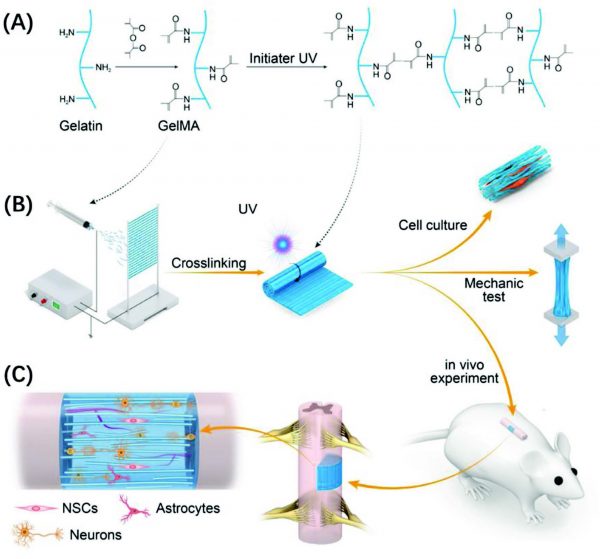一种仿生水凝胶静电纺丝纤维在脊髓损伤修复的研究
|
Adv. Funct. Mater. 2019, 29, 1806899 脊髓的重要作用是维持生命体特征,保持运动及感觉系统的正常运行。脊髓损伤损害患者的整体健康水平,造成社会经济重担。仿生支架由于定向的微槽及微管结构模拟脊髓的生理结构,进而指导神经轴突的再生可用于脊髓损伤。由于复杂的生理结构特征,需要支架具有特殊的要求,生物相容性以提高神经细胞的粘附,高含水量以满足细胞代谢的需求,高渗透性促进细胞迁移引导轴突延伸的三维纤维结构,此外,具有良好的柔韧性,当脊管打开时能抵抗各种压力下的变形。 最近,苏州大学第一附属医院骨科陈亮团队将光交联技术与静电纺丝技术结合,制备出明胶甲基丙烯酰胺水凝胶静电纺丝纤维(GelMA),以用于脊髓损伤的研究。结果表明,GelMA凝胶纤维具有高含水量,优异的弹性,为细胞提供良好的生存及代谢环境,促进细胞的增殖、分化及轴突的定向生长。体内实验表明,在脊髓损伤部位植入GelMA材料后能出现更多的NSCs、神经元、突触连接及血管内皮细胞,较少的胶质瘢痕。因此,GelMA水凝胶纤维有望成为脊髓损伤修复的生物材料。 As a component of the central nervous system (CNS), spinal cord not only plays a crucial role in the maintenance of vital signs, but also preserves the proper functioning of motion and sensory system. Hence, injury of this delicate cord could significantly compromise the general health condition of patients, inevitably leading to considerable social-economic burdens. Directional microgrooves or microtube structures of biomimetic scaffold were adopted to mimic the physiological structure of spinal cord and reported to guide the regrowth of nerve. Based on the physiological and anatomical characteristics of the spinal cord, the corresponding biological scaffolds should meet specific requirements as good biocompatibility to promote the adhesion of nerve cells, high water content to meet the needs of cell metabolism, highly permeable and oriented 3D fiber structure to facilitate cell migration and guide the axonal extension, and good flexibility to resist deformation under various stresses when the spinal canal is opened. Recently, the Liang Chen team who came from the First Affiliated Hospital of Soochow University, prepared an aligned GelMA hydrogel microfiber scaffold which constructed by synthesized photo-crosslinked GelMA and electrospinning technology for the repair of SCI. The high water content and elasticity of the mechanically soft scaffold can provide a favorable survival and metabolic environment for neuronal cells. In addition, the GelMA hydrogel electrospun fibers can promote cell proliferation, differentiation and axon directional growth. The immunohistochemical experiments in vivo demonstrated higher number of NSCs, neurons, synaptic connections and vascular endothelial cells, and less glial scar in the injury site. In summary, the GelMA hydrogel microfiber scaffold could be a promising candidate for pave the way toward the re-engineering of SCI, hopefully becoming possible to extrapolate this biomaterial to a range of applications in the future. 闫欢欢
|
